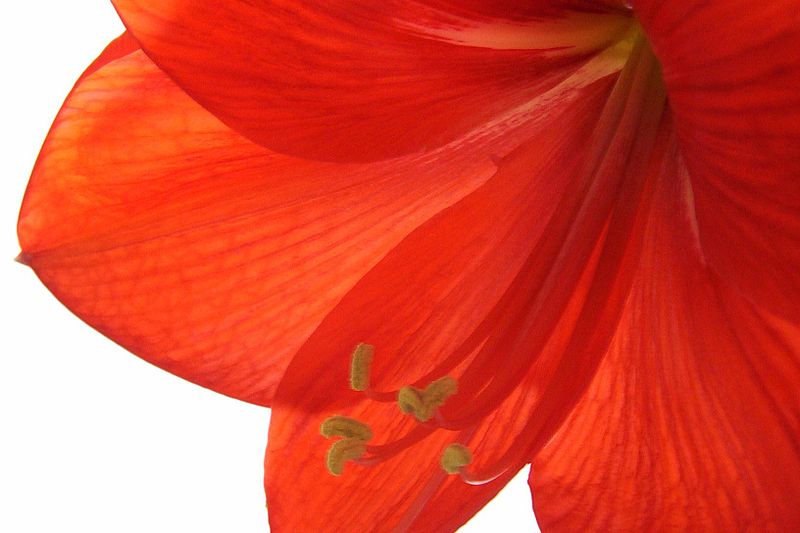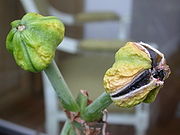
Hi Everybody!!
The big Spring "WOW" in the garden ends in dying flowers in the dirt. Everything is just green again, as colors fade away. All of a sudden, out of nowhere, big stalks begin to shoot up from the ground. Soon buds grow and pop open in a huge flower display. Now the spotlight is on the Lily! Your photostudy tonight is of my Saint Joseph Lily Bulbs. Some of these bulbs were originally planted when I was 7 yrs old helping my Mom plant dead looking onions. Turns out, they were not onions. What grew out of that old bulb amazed me so much that I have grown them ever since! Yes, I dug them up to every home I had. Fifty years later: Here they are. Easter will be coming now. I have shared info below from Wikipedia about these lilies and bulbs. I encourage you all to get one of these bulbs and plant it. These are among the easiest to grow, and they multiply. Enjoy!

https://en.wikipedia.org/wiki/Hippeastrum
Hippeastrum
From Wikipedia, the free encyclopedia
Hippeastrum /ˌhɪpiːˈæstrəm/[1] is a genus of about 90 species and over 600hybrids and cultivars of perennial herbaceous bulbous plants. They generally have large fleshy bulbs and tall broad leaves, generally evergreen, and large red or purple flowers.
Hippeastrum is a genus in the family Amaryllidaceae (subfamily Amaryllidoideae, tribeHippeastreae, and subtribe Hippeastrineae) [2] The name Hippeastrum, given to it byWilliam Herbert, means "Knight's-star-lily", although precisely what Herbert meant by the name is not certain. For many years there was confusion among botanists over the generic names Amaryllis and Hippeastrum, one result of which is that the common name "amaryllis" is mainly used for cultivars of this genus, often sold as indoor flowering bulbs particularly at Christmas in the northern hemisphere. By contrast the generic name Amaryllis applies to bulbs from South Africa, usually grown outdoors. The genus is native to tropical and subtropical regions of the Americas fromArgentina north to Mexico and the Caribbean.
Reproduction is generally by allogamy (cross-pollination) and Hippeastrum may be propagated by seed or offset bulbils (bulblets), although commercial ventures use in vitro techniques, or splitting of the bulb into sections. The genus has been intensely bred and cultivated since the early nineteenth century to produce large colourful showy flowers. In temperate climes these can be placed outside in the summer, and after a dormancy period, be induced to rebloom inside in the winter.
| Hippeastrum | |
|---|---|
 | |
| A Hippeastrum cultivar in flower | |
| Scientific classification | |
| Kingdom: | Plantae |
| Clade: | Angiosperms |
| Clade: | Monocots |
| Order: | Asparagales |
| Family: | Alliaceae |
| Subfamily: | Amaryllidoideae |
| Tribe: | Hippeastreae |
| Subtribe: | Hippeastrineae |
| Genus: | Hippeastrum Herb. |

https://en.wikipedia.org/wiki/File:Hippeastrum_miniatum_Blanco2.359.png
Description[edit]
Most Hippeastrum bulbs are tunicate (a protective dry outer layer and fleshy concentric inner scales or leaf bases). The bulbs are generally between 5–12 cm (2"–5") in diameter and produce two to seven long-lasting evergreen or deciduous leaves that are 30–90 cm (12"–36") long and 2.5–5 cm (1"–2") wide. The leaves are hysteranthous(develop after flowering), sessile, rarely persistent and subpetiolate.[3]
The flowers are arranged in umbelliform inflorescences which are pauciflor or pluriflor(2-14 flowers), supported on an erect hollow scape (flower stem) which is 20–75 cm (12"–30") tall and 2.5–5 cm (1"–2") in diameter with two free bracts forming a spathewhich is bivalve with free leaflets at its base.[4] Depending on the species, there are two to fifteen large showy flowers, which are more or less zygomophic and hermaphrodite. Each flower is 13–20 cm (5"–8") across, and the native species are usually purple or red. They are funnelform (funnel shaped)[5] and declinate (curving downwards and then upwards at the tip)[6] in shape. The perianth has six brightly colored tepals (three outer sepals and three inner petals) that may be similar in appearance or very different. The perianth segments are subequal or unequal.[7] The tepals are united at the base to form a short tube, usually with a rudimentary scaly paraperigonium[8] with fimbriae[9] or a callose ridge present at the throat.
The androecium consists of six stamens with filiform (thread like) filaments, which arefasciculate (in close bundles) and declinate or ascendent. The anthers are dorsifixed or versatile.[10] In the gynaecium, the ovary is inferior and trilocular with pluriovulatelocules.[11] The style is filiform, and the stigma trifid. The fruit forms a trivalve capsulecontaining seeds which are dry, flattened, obliquely winged or irregularly discoid, hardly ever turgid, and globose (spherical) or subglobose, with a brown or black phytomelanoustesta. [12]

Detail of Hippeastrum flower
History[edit]
Hippeastrum breeding began in 1799 when Arthur Johnson, a watchmaker in Prescot, England, crossed Hippeastrum reginae with Hippeastrum vitattum, obtaining hybrids that were later given the name Hippeastrum × 'Johnsonii' [62] (Johnson's amaryllis, 'hardy amaryllis' or St. Joseph's lily). Johnson shared his work with the Liverpool Botanic Gardenwhich was fortunate, since his greenhouse was destroyed in a fire. His hybrid was being cultivated in the US by the mid-nineteenth century.[51][63][64][65] Many new hybrid lines followed as new species were sent to Europe from South America, the most important of which were Reginae and Leopoldii.[36]
The Reginae strain hybrids were produced by Jan de Graaff and his two sons in theNetherlands in the mid 19th century by crossing Hippeastrum vitatum and Hippeastrum striatum with Hippeastrum psittacinum and some of the better hybrids available in Europe at the time. Some of the most successful hybrids were Graveana and Empress of India.[36][47]


link to photostudy in G+ Albums:
https://plus.google.com/u/0/photos/117645114459863049265/albums/6003136178979443745




https://en.wikipedia.org/wiki/Bulb
Bulb
From Wikipedia, the free encyclopedia

In botany, a bulb is a short stem with fleshy leaves or leaf bases[1] that function as food storage organs during dormancy. (In gardening, other kinds of storage organ are also called "bulbs" or "ornamental bulbs".)
A bulb's leaf bases, also known as scales, generally do not support leaves, but contain food reserves to enable the plant to survive adverse conditions. At the center of the bulb is a vegetative growing point or an unexpanded flowering shoot. The base is formed by a stem, and plant growth occurs from this basal plate. Roots emerge from the underside of the base, and new stems and leaves from the upper side. Tunicate bulbs have dry, membranous outer scales that protect the continuous lamina of fleshy scales.[2] Species in the genera Allium,Hippeastrum, Narcissus, and Tulipa all have tunicate bulbs. Non-tunicate bulbs, such as Lilium and Fritillaria species, lack the protective tunic and have looser scales.[3]
Other types of storage organs (such as corms, rhizomes, and tubers) are sometimes referred to as bulbs, although as the term is used in botany, they are not. The technical term for plants that form underground storage organs, including bulbs as well as tubers and corms, is geophyte. Some epiphyticorchids (family Orchidaceae) form above-ground storage organs calledpseudobulbs, that superficially resemble bulbs.
Nearly all plants that form true bulbs are monocotyledons, and include:
- Amaryllis, Hippeastrum, Narcissus, and several other members of the amaryllis family Amaryllidaceae. This includesonion, garlic, and other alliums, members of the Amaryllid subfamily Allioideae.
- Lily, tulip, and many other members of the lily family Liliaceae.
- Two groups of Iris species, family Iridaceae: subgenus Xiphium (the "Dutch" irises) and subgenus Hermodactyloides (the miniature "rock garden" irises).
Oxalis, in the family Oxalidaceae, is the only dicotyledon genus that produces true bulbs.[4][5]
Bulbous plant species cycle through vegetative and reproductive growth stages; the bulb grows to flowering size during the vegetative stage and the plant flowers during the reproductive stage. Certain environmental conditions are needed to trigger the transition from one stage to the next, such as the shift from a cold winter to spring.[2] Once the flowering period is over, the plant enters a foliage period of about six weeks during which time the plant absorbs nutrients from the soil and energy from the sun for setting flowers for the next year. Bulbs dug up before the foliage period is completed will not bloom the following year but then should flower normally in subsequent years.
After the foliage period is completed, bulbs may be dug up for replanting elsewhere. Any surface moisture should be dried, then the bulbs may be stored up to about 4 months for a fall planting. Storing them much longer than that may cause the bulbs to dry out inside and become nonviable.







...this is brendasue signing off from Rainbow Creek. See You next time!

From 2012 (same bulb)

https://plus.google.com/u/0/photos/117645114459863049265/albums/5741637091346837521
O+O



No comments:
Post a Comment
Hi Everybody! Please say hello and follow so I know you are here! Due to the inconsideration of people trying to put commercials on my blog comment area, I have restricted use of anonymous posts. Sorry that some hurt all.
My public email is katescabin@gmail.com No spammers or trolls